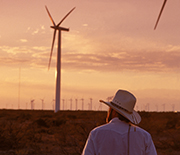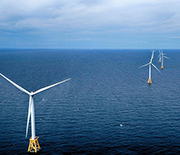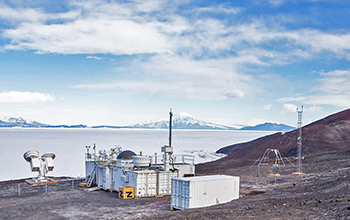
Research News
New research shows turbines reduce wind speed for up to several miles behind them
November 26, 2018
As onshore and offshore wind energy farms have proliferated in recent years, new research highlights a previously underexplored consequence: a wake effect from upwind wind farms that can reduce the energy production of downwind neighbor turbines.
The study, by University of Colorado Boulder (CU-Boulder) scientists working with University of Denver and National Renewable Energy Laboratory (NREL) researchers, combines economic analysis with atmospheric modeling to demonstrate that these wake effects — which occur when groups of turbines reduce wind speed for up to several miles behind them — are measurable and predictable, yet remain largely overlooked.
“This project explores the links among economic, legal and social issues and the geophysical processes in wind energy production,” said Tom Baerwald, a program director for the National Science Foundation’s (NSF) Dynamics of Coupled Natural and Human Systems program, which funded the research. “The results advance our understanding of these interactions and provide guidance for successful development of renewal energy for the future.”
The findings appear this week in the journal Nature Energy.
“We highlight the need for coordinated development and awareness of the big picture to maximize wind energy generation nationwide,” said Julie Lundquist, lead author of the study and a scientist at CU-Boulder.
The researchers found that wind energy developers seek out sites with reliable wind resources and access to electrical transmission lines, leading to dense turbine construction in choice areas, with little coordination between competitors. Nearly 90 percent of U.S. wind farms are located within 25 miles of another wind farm — and often much closer.
Yet, much like a homeowner whose once-unimpeded views are blocked by new construction, the study shows that existing wind farms stand to lose valuable energy production if they suddenly find themselves downwind of a new neighbor and its wind- and energy-reducing wake.
Using publicly available data on monthly energy generation and dominant wind direction, the researchers modeled the wake effect on a pair of West Texas wind farms, using a third wind farm as a control.
They found that wind speed reductions due to the establishment of the upwind farm reduced power generation at the downwind farm by 5 percent between 2011 and 2015, an estimated revenue loss of around $3.7 million.
“Just as upstream water users can knowingly or unknowingly impose additional costs downstream, the same effect is in play here,” said Daniel Kaffine of CU-Boulder, a co-author of the study. “We had a general sense of this interaction before and wanted to explore it using a mix of social science and atmospheric data.”
Kaffine and Lundquist noted that Texas makes for a good case study because of its current and future stake in wind energy development.
More than a century ago, oil and gas law recognized the “rule of capture,” which allows a landowner to capture a neighbor’s oil resources by taking them from an adjacent well. This resulted in poor well-field recoveries and waste, so states intervened to regulate production through well-spacing, pooling and other coordination measures.
Similarly, states have developed water law regimes that protect rights for prior users. But current U.S. property law contains no similar provisions for wind energy.
Turbine wakes may extend up to 25 miles, potentially spanning multiple state and county jurisdictions and complicating matters.
“In the immediate future, some business incentives might change,” Kaffine said. “Energy firms might put more emphasis on securing leases upwind to ensure they have enough of a buffer.”
Lundquist emphasized that the team’s sophisticated atmospheric science simulations show that the wake effect is a predictable atmospheric phenomenon that can be modeled and planned for in light of the new data.
“The strongest wakes occur at night, when the atmosphere is stable and wind speeds and directions meet specific criteria,” said Lundquist. “In the month of wakes simulated, only 28 hours, or less than 4 percent of the time, had wakes in excess of 20 percent of the downwind farm’s capacity, suggesting this episodic issue can be predicted and managed.”
Taking the wake effect into account will be especially important for the large number of offshore wind farms currently in development off the U.S. East Coast, Lundquist added.
“Offshore wind farms are important, but they are expensive to build — and mistakes will be equally expensive,” she said.
The researchers hope to expand their efforts to measure wind farm wake effects by incorporating aircraft measurements as well as obtaining data on more frequent timescales from other sites around the country.
NREL and the U.S. Department of Energy’s Wind Energy Technologies Office provided additional funding.
—
Cheryl Dybas,
NSF
(703) 292-7734 cdybas@nsf.gov
—
Trent Knoss,
CU-Boulder
(303) 735-0528 trent.knoss@colorado.edu
-
Inside view of a wind turbine tower, showing the tendon cables.
Credit and Larger Version -
The King Mountain Wind Ranch in Texas added almost 77 megawatts to the state’s wind power capacity.
Credit and Larger Version -
Offshore wind farms, such as this one off Block Island, Rhode Island, face similar challenges.
Credit and Larger Version -
Wind turbines stretch across Iowa. The 193-turbine Rolling Hills Wind Farm is the state’s largest.
Credit and Larger Version -
The Dry Lake Wind Power project in Arizona, another state that’s developing wind power.
Credit and Larger Version
Related Programs
Dynamics of Coupled Natural and Human Systems
Source: NSF News
Brought to you by China News













